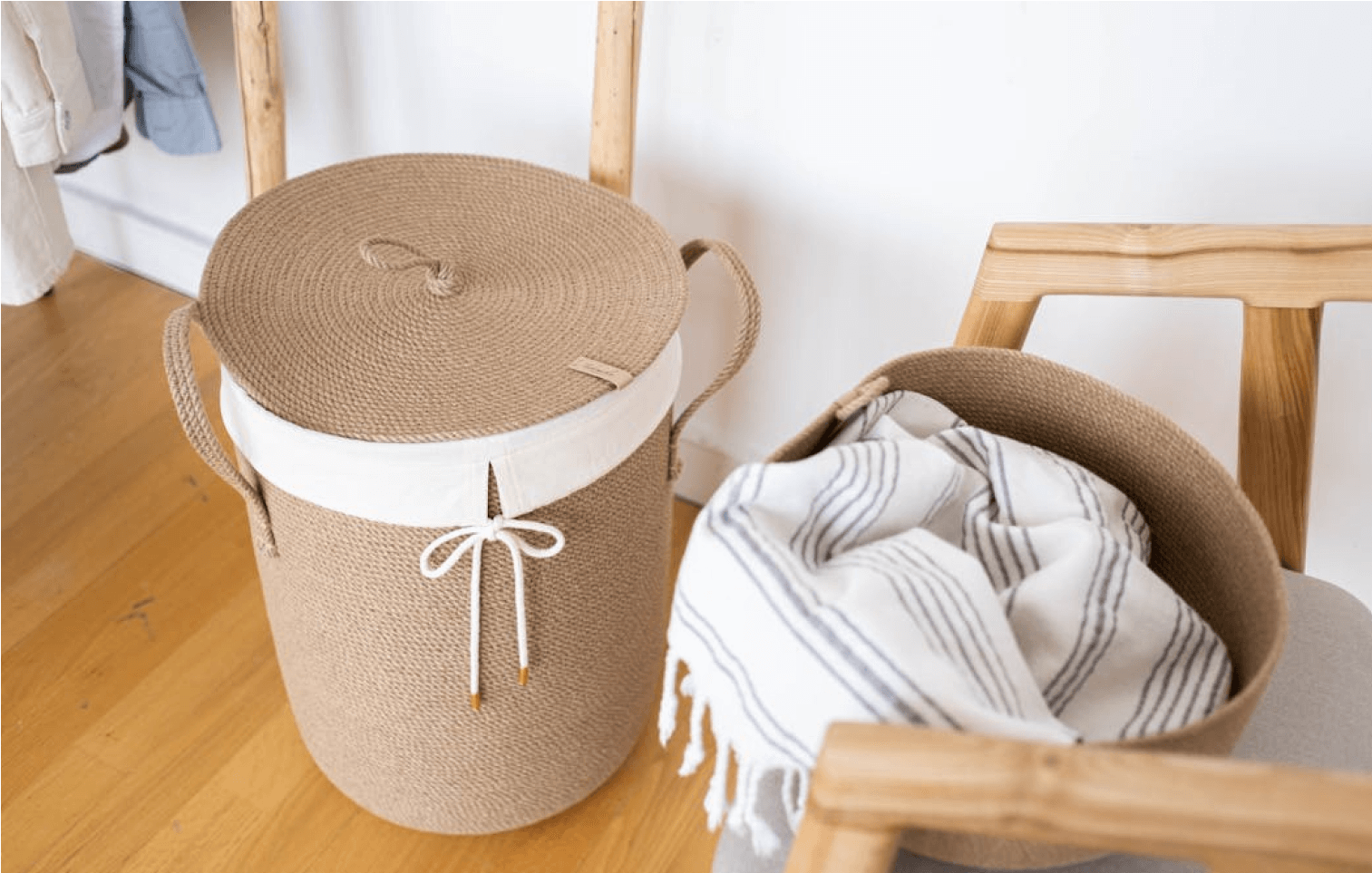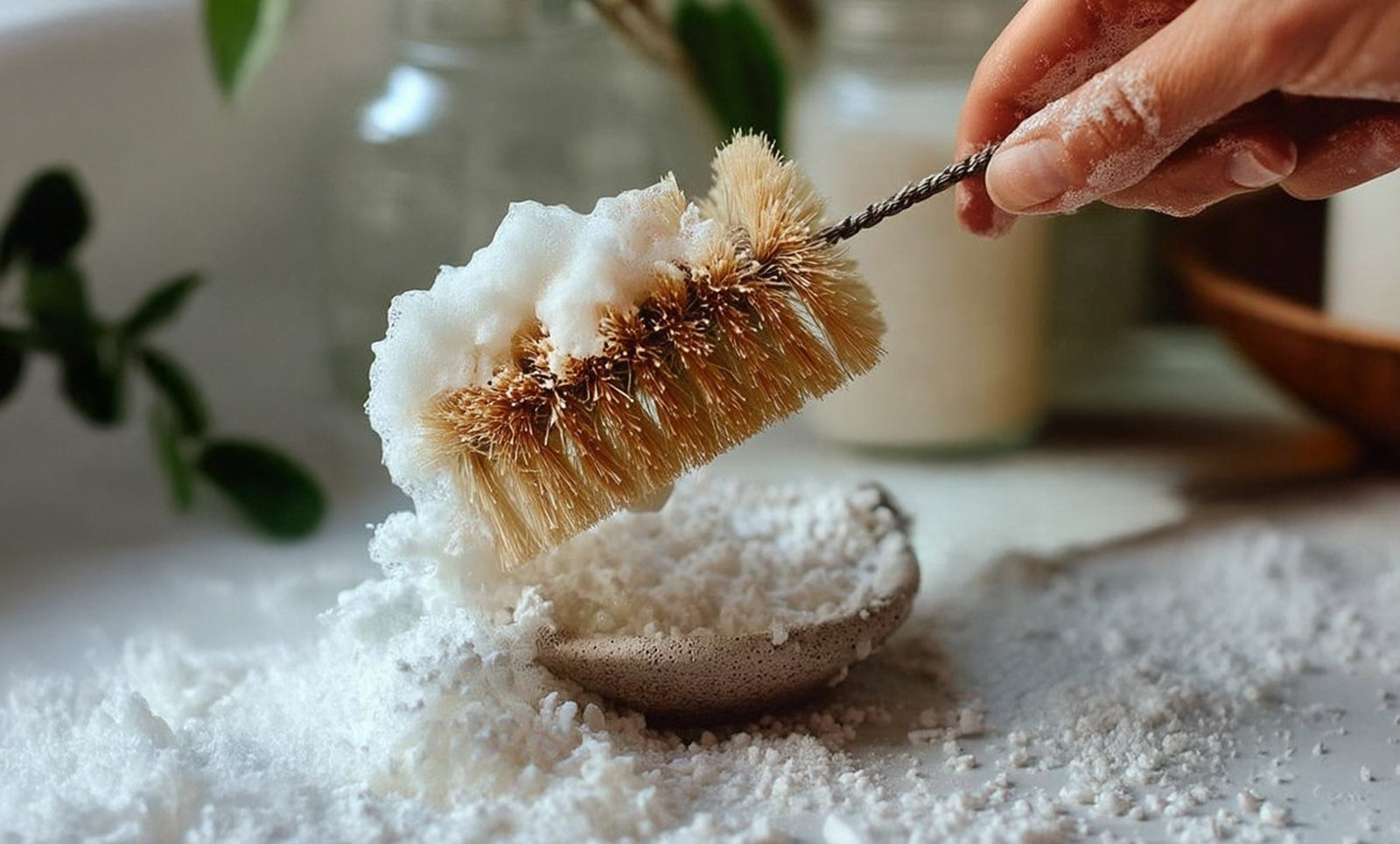Why Your Clothes Still Smell After Washing & How to Fix It

Laundry is a never-ending task, especially if you have babies and/or kiddos at home.
So, when you sit down to fold a mountain of clean clothes after a long day, discovering they still smell can be disheartening, to say the least.
Did you not use enough detergent (or forgot to add detergent entirely, oops!)? Is your favorite natural detergent malfunctioning? Did the clothes sit in the washer for too long? Or is your washer on the fritz?
If your clothes still smell after washing, consider these tips and solutions to address the root cause and get your laundry routine back on track.
7 Reasons Why Your Clothes Still Smell After Washing
The first step to solving the clean-yet-smelly clothes dilemma is to uncover the root cause.
Here are five common reasons why your clothes still smell after washing.
1. Clothes Left In The Machine Too Long
We’ve all experienced the stale smell of clothes left in the washer for too long.
Although this is more common with top-loaders, clothing left in the washing machine for a day, or even overnight in some cases, can result in a stinky smell.
2. Overfilling The Machine
Most of us are far too busy to stress over the ideal laundry load size.
However, overfilling the washing machine often results in suboptimal cleaning and stinky clothes.
Additionally, these larger-than-life loads typically don’t dry properly, which can contribute to the clean yet unpleasant scent.
3: Detergent Mishaps (Too Much, Too Little, The Wrong Type)
Adding too much or too little detergent can affect how your clothes smell after washing.
Too much detergent can prevent a thorough rinse and cause waterlogging in fabrics, resulting in dampness, incomplete drying, and offensive odors.
In contrast, using too little detergent prevents a thorough clean, which can also lead to stinky clothes.
Related reading: Branch Basics Laundry Instructions
4: Incomplete Drying
Clothes that don’t dry completely can develop mildew and various smells, especially if forgotten in the dryer or put away damp.
Drying smaller loads can help prevent this.
Related reading: Sunning: How To Take Advantage Of The Summer Sun By Outgassing (Off Gassing)
5 Build-Up In The Washing Machine
Most washing machines have a self-clean setting, which helps remove dirt, bacteria, and scale that can affect performance over time.
If you notice an odor immediately after removing your clothes from the washer (and you’re sure you added detergent) it could indicate the need for a self-wash cycle.
But don’t use bleach, even if indicated, as it releases toxic fumes!
We’ll discuss safer alternatives in the next sections.
Related reading: How To Clean And Detoxify Your Washer And Dryer
6: Fabric Softener Build-Up
Most articles on smelly clothes neglect to mention fabric softener build-up.
Fabric softeners work by reducing static while coating clothes in a chemical concoction that creates a soft sheen and feel.
Unfortunately, this coating builds up over time, making detergents less able to penetrate fabrics, and creating a fire hazard in dryers (for real!).
The simple solution for this is to strip your clothes and stop using conventional fabric softener (which is ultra toxic anyway).
Get more tips in: 7 Legit Natural Fabric Softener Alternatives
7: Clothing Type
Certain fabrics, like polyester, rayon, and other synthetics are more likely to hold onto odors than natural fabrics, like cotton, linen, and wool.
This is especially true for athletic or sport’s apparel, which absorbs sweat and odors.
Curious about switching to non-toxic, breathable clothing?
Check out: How To Choose Healthy And Sustainable Clothing for more details and our favorite brands.
How to Prevent Your Clothes From Smelling After Washing
An ounce of prevention is worth a pound of cure (and several pounds of clean-smelling clothes).
Once you’ve identified the cause, here’s how to take steps to prevent it from happening again.
Clean Your Washing Machine
This is often the best first step, especially if you’re not sure why your clothes still smell after washing.
Washing machines should be cleaned about once a month, or less frequently, depending on how often you do laundry.
For big families, once a month is recommended; for a single person or couple, every two months is probably fine.
Most washers have a self-wash setting and recommend using bleach to kill mold, mildew, and bacteria.
Although bleach is effective, it's also a highly toxic VOC associated with lung irritation, hormonal disruption, microbiome disruption, greater susceptibility to infections in adults and children, asthma, and various other ill health effects (even from passive exposure).
Instead, we recommend using a cup of plain old baking soda, distilled white vinegar, apple cider vinegar, or 3% hydrogen peroxide separately in a hot wash cycle.
If you are inclined to double up on products, know that vinegar and baking soda cancel each other out in this application, and combining vinegar and peroxide will create a toxic gas.
So use these separately, not together.
Run the cycle, open the door to dry and prevent mold and mildew build-up, and you’re done.
For more tips on cleaning and detoxifying your washing machine from detergent and fragrance, see: How To Clean And Detoxify Your Washer And Dryer
Try A Different Detergent
Stinky clothes can be a great excuse to upgrade your laundry detergent to a more human-safe, fragrance-free, and natural alternative.
Many synthetic chemical laundry detergents contain ingredients, like built-in fabric softeners and bleach, that can degrade fabric quality and prevent thorough cleaning over time.
Branch Basics Laundry Detergent, Laundry Dilution, and Oxygen Boost are excellent options for thorough cleaning, brightening, whitening, stain removal, and deodorizing without any harmful chemicals like SLS/SLES, bleach, ammonia, optical brighteners, sulfates, 1-4 dioxane, or fragrance.
Learn more in: 10 Natural Laundry Detergent Alternatives That Actually Work and Comparing Branch Basics Laundry Detergent Vs. Laundry Dilution: What’s The Difference?
Avoid Leaving Clothes in The Machine For Too Long
Removing clothing from the washer promptly is one of the easiest and most effective ways to prevent clean-yet-smelly-clothes-syndrome.
This is especially important in humid climates, where stench can set in fast.
One thing we’ve found helpful when we’re unsure how fast we’re able to move clothes along is to use the delay function.
This works great for overnight loads or starting a load before you go out. You can typically delay loads between 1-12 hours with a push of a button.
Soak Clothing in Vinegar
Vinegar is a wonderful natural deodorizer, fabric softener, and bleach alternative, and can be used as a soak or rinse aid to remove odors from clean clothes.
To soak:
- Fill a large sink or basin with warm water and add 1-2 cups vinegar.
- Let clothes soak for 1-4 hours.
As a rinse aid:
- Add 1 cup of vinegar directly to your wash to deodorize, freshen, and soften clothing (the smell will come out in the dryer).
- It is best to add vinegar to the fabric softener dispenser so it is released during the rinse cycle. Vinegar has a low acidic pH due to the acetic acid content, and laundry detergents have an alkaline pH. If mixed, the cleaning power of the laundry detergent is reduced.
Related: 12 Ways To Use Vinegar In Your Home
Deodorize Clothing With Baking Soda
Like vinegar, baking soda serves as a natural deodorizer, fabric softener, and alternative to bleach. Baking soda is a wonderful laundry booster that doesn’t interfere with the pH balance or cleaning performance.
It can be used to soak smelly clothes or directly in the washer with your favorite natural detergent.
Related reading: Cleaning With Baking Soda (Sodium Bicarbonate): 12 Surprising Uses
What Types of Clothing Are Prone to Bad Smells?
As previously discussed, synthetic clothing doesn’t breathe and is therefore more likely to hold onto odors and unpleasant smells.
Wool can also get smelly, especially if it’s not washed and dried properly or not washed frequently enough.
This is why we recommend choosing breathable clothing made of natural fibers as much as possible. It not only smells better, but it’s better for the environment and your overall health.
Toss The Toxins With Branch Basics
There you have it! The causes and solutions for all your stinky-clean-clothes woes.
If you’re looking for human-safe, biodegradable, and natural laundry solutions that really work, you’ve got to check out Branch Basics.
Our Laundry Detergent (powder), and Laundry Dilution (liquid) will clean, deodorize, and freshen your clothes thoroughly and economically, and double as stain removers.
We also offer Oxygen Boost, a two-ingredient mineral-based laundry booster, deodorizer, stain remover, bleach alternative, scouring agent, and soaking agent, as well as wool dryer balls to replace toxic fabric softeners.
All our laundry products (and cleaning products) are free from harmful synthetic chemicals and allergens, including: fragrance, dyes, optical brighteners, ammonia, chlorine, endocrine disruptors, 1,4-Dioxane, sulfates, SLS, and SLES.
Shop all Branch Basics Laundry Products here.
Looking for more natural laundry advice & tips?
Click the links above and check out the following articles:
-
Laundry Bleach Alternatives: 7 Human-Safe and Environmentally Safe Options
-
Breaking Down The Ingredients In Our Human-Safe Laundry Detergent
-
Detoxifying Your Laundry Room
-
6 Safe Laundry Room Essentials: A Complete Checklist
- Top 7 Natural & Reliable Laundry Stain Removers
Categories

Marilee Nelson
Marilee Nelson is an Environmental Toxins expert who has spent nearly 30 years advocating for the chemically-sensitive and chronically-ill. She is a Board Certified Nutritionist, Certified Bau-Biologist and Bau-Biology Inspector and specializes in Food As Medicine. She has helped thousands of families and individuals identify, heal and recover from toxic exposures and is on a mission to revolutionize the way American families view their health.








